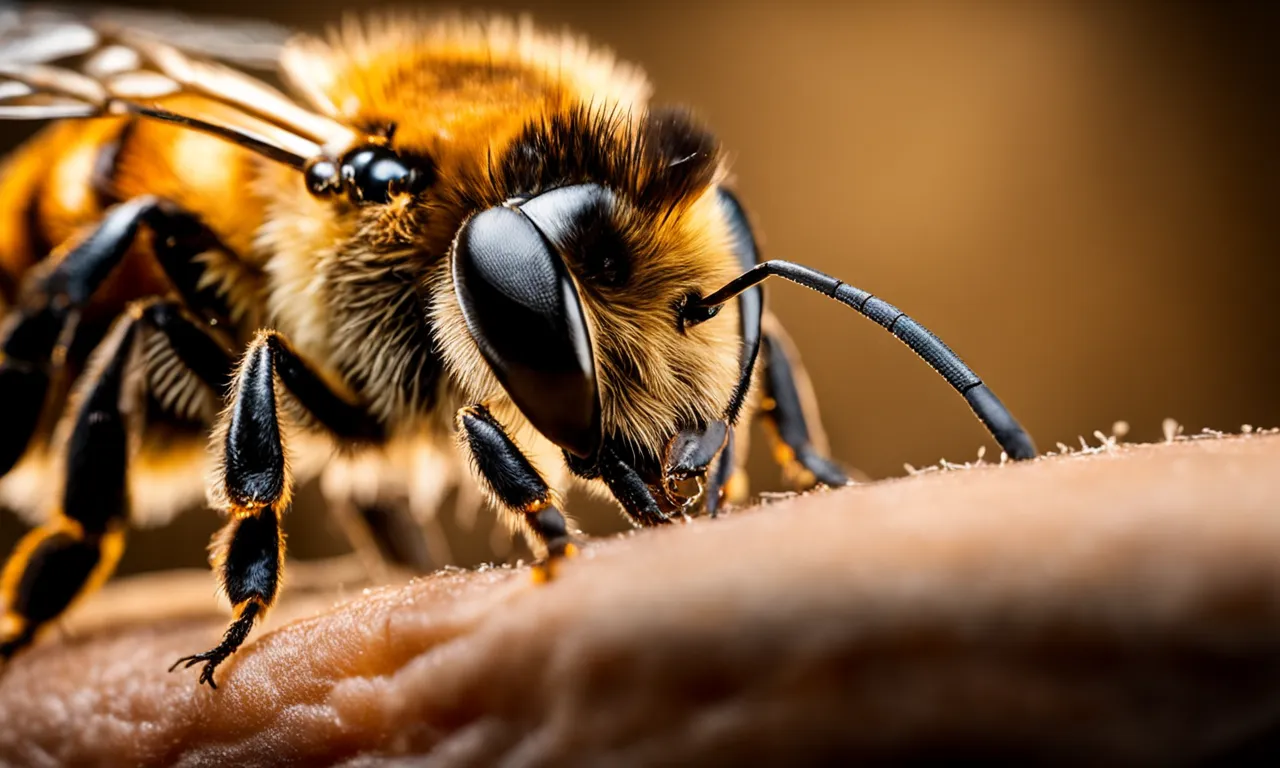Bee Stinger Vs Needle: A Detailed Comparison
Bees are one of nature’s most incredible creatures. Their ability to sting as a defense mechanism is both fascinating and somewhat troubling for us humans. But how exactly does a bee’s stinger compare to a needle that we use for sewing or medical procedures?
Read on as we take an in-depth look at the similarities and differences between bee stingers and needles.
If you’re short on time, here’s a quick answer to your question: A bee’s stinger is barbed while a needle is smooth. The venom in a bee stinger causes pain and inflammation while a needle is relatively harmless. Both can puncture skin but a bee stinger detaches while needles remain intact.
Anatomy and Structure
When comparing a bee stinger to a needle, it is important to understand the anatomy and structure of both. A bee stinger is a specialized organ found at the posterior end of a bee’s abdomen. It consists of three main parts: the stylet, venom sac, and barbs.
The stylet is the sharp, pointed structure that pierces the skin. The venom sac is located at the base of the stylet and contains venom that is injected into the victim. The barbs, which are unique to bee stingers, are small hooks that allow the stinger to remain embedded in the skin.
Barbed Stinger vs Smooth Needle
One of the key differences between a bee stinger and a needle is the presence of barbs on the bee stinger. The barbs on a bee stinger serve an important purpose. When a bee stings, the barbs on its stinger become embedded in the skin, making it difficult for the bee to remove its stinger.
As a result, the bee’s stinger is torn away from its body, causing the bee to die shortly after stinging.
On the other hand, a needle, such as those used for medical purposes, does not have any barbs. This allows the needle to be easily inserted and removed from the skin without causing any damage or tearing.
The smooth surface of a needle also reduces the amount of pain experienced during insertion and removal.
Detachable Stinger vs Fixed Needle
Another important distinction between a bee stinger and a needle is the ability to detach. A bee stinger is attached to the bee’s body and is designed to be left behind after stinging. This detachment is due to the barbs on the stinger that become embedded in the skin.
Once the stinger is detached, it continues to pump venom into the victim, causing further pain and irritation.
In contrast, a needle is fixed and does not detach from its handle. This allows for precise control during medical procedures and reduces the risk of leaving any foreign objects inside the body. The fixed nature of the needle also ensures that the needle can be safely disposed of after use, minimizing the risk of accidental injuries.
Understanding the differences in anatomy and structure between a bee stinger and a needle can help us appreciate the unique features and purposes of each. While a bee stinger may be a formidable weapon for a bee’s defense, a needle is a versatile tool used in various medical procedures.
So, the next time you encounter a bee or need a medical injection, you’ll have a better understanding of the differences between these two fascinating structures.
Purpose and Function
When comparing a bee stinger and a needle, it is important to understand their purpose and function. While both have a pointed end, they serve very different roles in different contexts.
Defense vs Utility
The primary purpose of a bee stinger is defense. Bees use their stingers as a means of protection against predators. When a bee feels threatened, it will sting the perceived threat, injecting venom into the intruder. This venom can cause pain, swelling, and allergic reactions in humans.
The stinger is barbed, which means that once it penetrates the skin, it remains there, tearing the bee’s abdomen and causing its death.
On the other hand, needles are primarily used for utility purposes. Needles are commonly used in medical procedures to administer medication, draw blood, or perform various diagnostic tests. They are also used in sewing, knitting, and other forms of crafting.
Unlike bee stingers, needles are not barbed and can be easily inserted and removed without causing harm.
Venom Delivery vs None
One of the key differences between a bee stinger and a needle is their ability to deliver venom. Bee stingers are equipped with venom sacs, which contain venom composed of various chemicals. When a bee stings, the venom is injected into the victim’s skin, causing the characteristic reaction.
The venom serves as a defense mechanism for the bee and can vary in potency depending on the species.
Needles, on the other hand, do not deliver venom. They are simply sharp instruments designed to penetrate the skin for various purposes. The absence of venom delivery makes needles safer to handle and less likely to cause severe reactions or harm to the person being punctured.
Puncturing Ability
Skin Penetration
When comparing the puncturing ability of a bee stinger and a needle, it is important to consider the differences in their structures. A bee stinger is designed to penetrate the skin of its intended target, injecting venom in the process.
On the other hand, a needle is typically used for medical purposes, such as drawing blood or administering medication. While both bee stingers and needles can penetrate the skin, the mechanism and purpose behind their puncturing abilities differ.
When a bee stinger penetrates the skin, it is equipped with tiny barbs that allow it to effectively lodge itself in the flesh. This is what causes the stinger to remain embedded in the skin after a bee has stung.
In contrast, a needle used in medical procedures is typically smooth and lacks these barbs, allowing for easy insertion and removal.
Depth of Puncture
Another aspect to consider when comparing the puncturing ability of a bee stinger and a needle is the depth of the puncture they create. Bee stingers are designed to penetrate just deep enough to inject venom into the target.
The depth of the puncture may vary depending on the species of bee and individual factors such as the force of the sting.
On the other hand, needles used in medical procedures can be adjusted to control the depth of the puncture. This allows healthcare professionals to cater to the specific needs of their patients, ensuring accurate and effective treatment.
The ability to control the depth of the puncture is crucial in medical settings to avoid complications or injuries.
It is important to note that the information provided is for educational purposes only. If you require medical advice or have any concerns, please consult a healthcare professional.
Effects on Human Body
Pain and Inflammation
Both bee stingers and needles can cause pain and inflammation when they penetrate the human body. However, the pain from a bee sting is often more intense and immediate. The venom injected by the bee triggers a rapid inflammatory response, leading to redness, swelling, and a burning sensation at the site of the sting.
In contrast, the pain caused by a needle is usually milder and lasts for a shorter duration, as it does not involve venom injection.
When a person is stung by a bee, the body’s immune system reacts to the venom, releasing histamines and other chemicals to combat the foreign substance. This immune response can often cause a localized allergic reaction, resulting in itching, hives, or even anaphylaxis in severe cases.
On the other hand, when a needle pierces the skin, the body may experience a minimal immune response, leading to a more controlled and less severe inflammatory reaction.
In cases where an individual has a known allergy to bee stings, the effects on the human body can be much more severe, potentially leading to life-threatening situations. It is essential for individuals with bee sting allergies to carry an epinephrine auto-injector, commonly known as an EpiPen, to counteract the allergic reaction until medical help arrives.
Bleeding and Healing Process
When it comes to bleeding, bee stingers are designed to penetrate the skin and deposit venom, while needles are typically sharp and hollow to allow for the injection or extraction of fluids. As a result, bee stings often cause minor bleeding at the site of the sting, especially if the stinger is not promptly removed.
The venom itself acts as an anticoagulant, which can prolong bleeding.
On the other hand, needles used in medical procedures are designed to minimize bleeding by puncturing blood vessels cleanly and efficiently. The healing process after a bee sting involves the body’s natural wound healing mechanisms, such as blood clotting, cell regeneration, and scar formation.
Similarly, the healing process after a needle puncture involves the formation of a scab, tissue repair, and eventual scar reduction.
It’s important to note that both bee stingers and needles can introduce bacteria or other pathogens into the body, potentially leading to infection. Proper wound care and hygiene practices, such as cleaning the area thoroughly and applying antiseptic ointment, can help minimize the risk of infection.
For more information on bee stings and their effects on the human body, you can visit the Mayo Clinic website.
Conclusion
In conclusion, while both can puncture skin, the bee stinger and needle have several key differences. The barbed and detached stinger delivers venom that causes pain and inflammation. Meanwhile the smooth, fixed needle is versatile for utility purposes and relatively harmless.
Understanding the unique features of each can help us admire the bee’s ingenious defense, while continuing to utilize needles safely.







